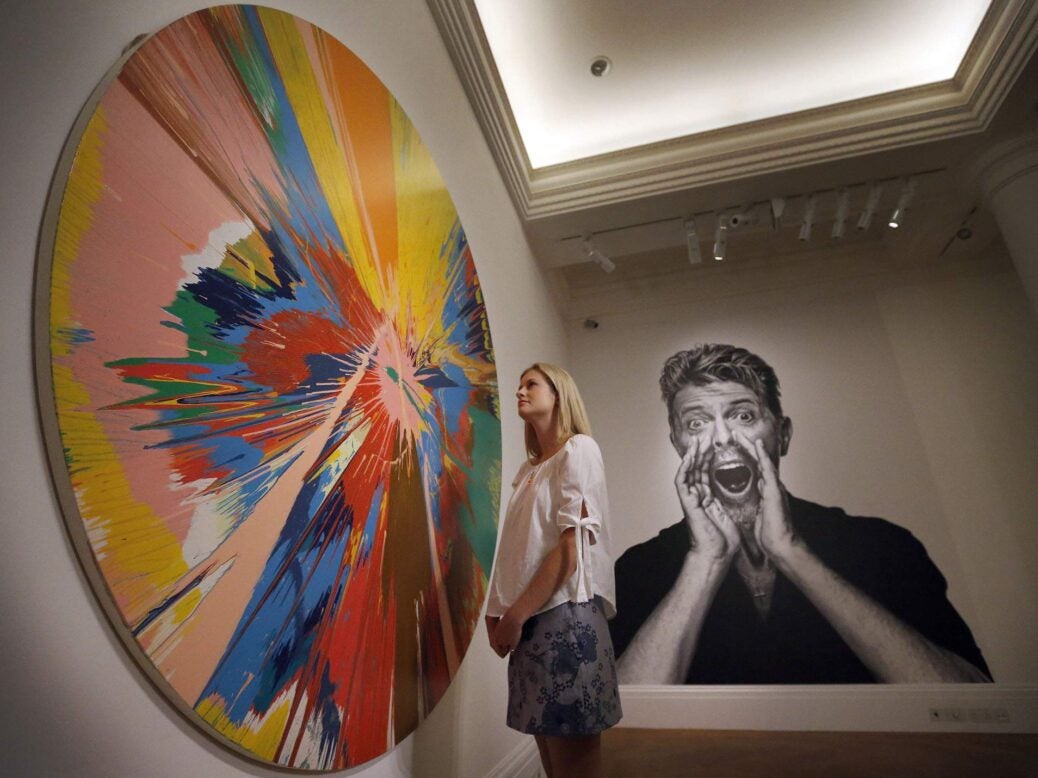
The auction of David Bowie’s eclectic art collection demonstrates the value of art as a tax-offsetting investment says Rosalind Hetherington
Part of the wonderfully eclectic collection of artworks accumulated by the late David Bowie went under the hammer at Sotheby’s earlier this month. Unsurprisingly, many works sold for prices that exceeded the estimates given by the auction house. I believe it might be fair to call this the ‘Bowie effect’. For example, a Damien Hirst spin painting was estimated to sell for £250,000 – £350,000 but sold for over double the estimate at £785,000. Why? Because the piece (called ‘Beautiful. Hallo. Space-Boy’) was produced by Damien Hirst and David Bowie together.
Perhaps not all works owed their success to their owner. Some pieces may have been able to beat their estimates without the cache of being owned by the illustrious star. Others were already popular in the market place (for example, Basquiat pieces have been reaching record prices recently, one of the headline pieces of the Bowie collection was a Basquiat which was estimated to sell for £2.5 – £3.5 million and sold for £7.093 million). Others may simply be timeless pieces that often prove popular in sales (an example, in the writer’s personal opinion, is the charming Henry Moore ‘Family Group’ sculpture).
To put the ‘Bowie effect’ into cold hard figures, the sale was expected to raise between £11,680,000 and £17,080,000. In fact, cumulative sale proceeds were £32,906,250.
But, what does this have to do with mere mortals who cannot rely on an eponymous effect to increase the value of their art collection? The Bowie collection may be remembered for having far exceeded its estimates but what else shows is that something which gave great pleasure in the life of the owner can also provide benefits after death.
The proceeds of the sale will be paid to Bowie’s estate. This means that the proceeds can be used to meet any inheritance tax (or similar estate taxes) that are due. Bowie’s estate was reported to be worth nearly $100 million, roughly £69 million, at the time of his death. If the estate was subject to UK inheritance tax £27 million would be payable.
Therefore, theoretically, the entire inheritance tax burden could be met by the sale of the art. Furthermore, an art collection, especially one of such a personal nature, can often be difficult for the deceased’s loved ones to retain, whether due to its emotive, highly personal connection with the deceased or simply because the heirs do not have the ability to store, display and protect the collection appropriately. It is, however, an asset class than can be disposed of in order to raise money, which is especially useful in asset rich but cash poor estates where the only other significant asset might be the main family home.
Selling through an auction house may mean that the estate must pay fees for the sale of works. Is there another option? In the UK, the Government operates a system whereby HMRC can accept artworks in lieu of inheritance tax. This is one of the reasons why our national museums have such a wonderful collection of artworks (check the labels in museums as works are often listed as being accepted in lieu of tax). The executors of an estate can enter into negotiations for a particularly valuable piece or a collection to be accepted in lieu of tax due.
If the transfer is approved by HMRC (and there are specific criteria which must be satisfied), up to the full market value of the work may be accepted in lieu of part or all of the tax due (although the tax is paid first, then refunded). The idea behind the scheme is to allow the nation to retain culturally significant works rather than the works being sold to private buyers. Such gifts to the nation can also be made in the owner’s lifetime to provide a reduction in other tax liabilities (the Cultural Gifts Scheme).
But aren’t artworks inherently risky assets, too prone to the vagaries of the market to be used as a planning tool? Perhaps. It may not be for the faint hearted but increasingly artworks are not only seen as objects that give great pleasure (and kudos) to the owner, they are also being seen as an investment asset.
There are now a number of investment funds that operate sub-funds investing in art as a method of diversifying assets. As the art market opens up to more and more buyers from emerging markets, the investment opportunities increase. This investment element, and its ability to offset tax, is attracting more than an aesthetic appreciation.
Rosalind Hetherington works at boutique private client law firm Maurice Turnor Gardner LLP.






